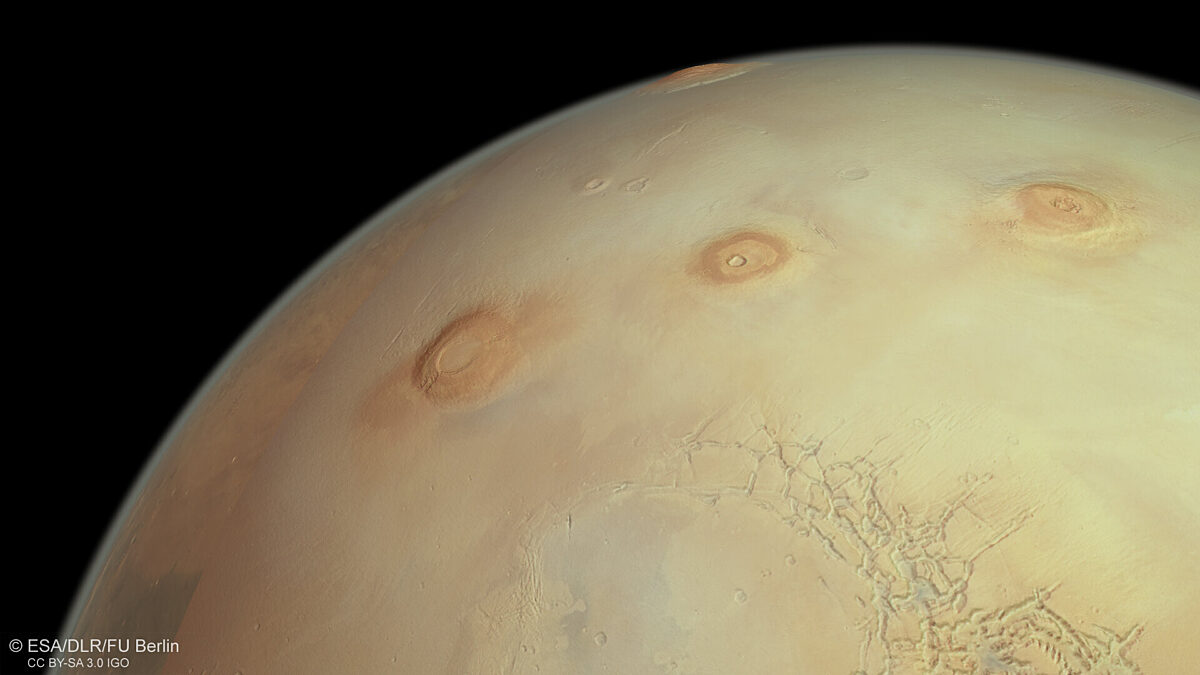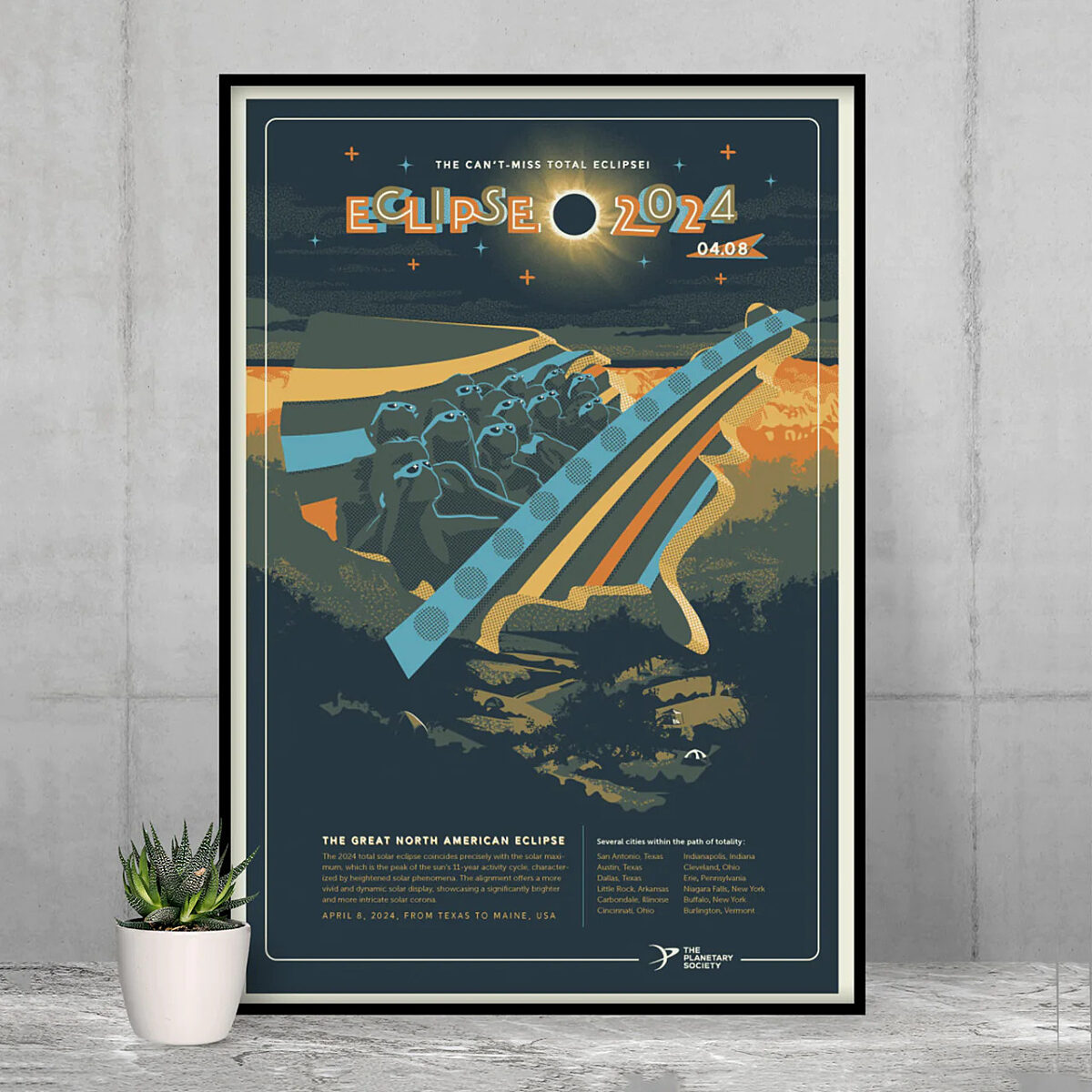The Downlink • Apr 26, 2024
Volcanoes are so hot right now
Space Snapshot

The European Space Agency shared this image of Mars to celebrate the 25,000th orbit of the Mars Express spacecraft. You can see three of Mars’s famously colossal volcanoes in a row (from left to right: Arsia, Pavonis, and Ascraeus Mons) with the mound of Mars’s largest volcano, Olympus Mons, at the top of the frame. Image credit: ESA / DLR / FU Berlin.
Fact Worth Sharing

Mars’ Olympus Mons is nearly three times the height of Mount Everest but has such a wide base that its slopes average only about 5 degrees. At such a mild grade, climbing Olympus Mons would be an extremely long but relatively gentle hike.
Mission Briefings


Io appears to have been volcanic for its entire 4.5-billion-year lifetime. New research using the Atacama Large Millimeter/submillimeter Array (ALMA) suggests that the moon of Jupiter, which today is the most volcanically active body in the Solar System, has likely maintained this level of activity since it was first formed. Pictured: Io imaged by NASA’s Galileo spacecraft in 1999. Image credit: NASA / JPL / University of Arizona.

NASA has reestablished communications with Voyager 1. For the first time since November, the Voyager 1 spacecraft is returning data to Earth about the status of its onboard engineering systems. Mission engineers are now working on getting the spacecraft to resume returning science data.

Private companies are proposing missions to the asteroid Apophis. The asteroid will pass closer to the Earth than geostationary orbit on April 13, 2029, providing a rare opportunity to study a large asteroid up close. The OSIRIS-APEX mission is already planning to rendezvous with the asteroid after its closest approach to Earth, but this week several private companies pitched additional missions for consideration.

Canada is establishing a National Space Council. In the latest federal budget, the Government of Canada announced plans to form a National Space Council to coordinate space efforts across various parts of government. The Canadian Space Agency also received a proposed $8.6 million CAD for its lunar program, including participation in Artemis and the Lunar Gateway.
From The Planetary Society


Lava on Io is among the hottest things in the Solar System. Volcanoes like the one pictured above in Io’s Tvashtar Catena region spew lava onto the moon’s surface that reaches searing temperatures. This earns Io a spot among the hottest places in the Solar System. Meet the other toasty worlds and their frigid counterparts in our guide to some of the most extreme temperatures out there.

Magma or lava? What’s the difference? When magma from the mantle breaks through the crust of a planet and reaches the surface, it becomes lava. But what is a mantle, and what is a crust? Get the full breakdown of what planets are made of, from terrestrial worlds like Earth to ice and gas giants and even planets beyond our own Solar System.

NASA’s solar sailing spacecraft has launched. The Advanced Composite Solar Sail System (ACS3) spacecraft launched into Earth orbit on April 23, beginning a mission to test a solar sail spacecraft with booms made of composite materials. This mission builds on the legacy of The Planetary Society’s LightSail 2 mission, which demonstrated that small spacecraft like this can use solar sails for controlled propulsion.

The Day of Action is coming up, and you can take part from home. While Planetary Society members meet in Washington, D.C., on April 29 to speak with their representatives in Congress about the value of investing in space science and exploration, you can echo those same messages from home. Fill out our pledge form to take at-home actions, and we will email you with instructions and special opportunities to email and make phone calls to your members of Congress.
What's Up

Jupiter shines very brightly in the western evening skies. Look for reddish Mars and yellowish Saturn in the pre-dawn east, low to the horizon.
Commemorate your eclipse experience

Want a memento from the April 8 total solar eclipse? We’ve got just the store for you. To help hold onto your eclipse memories forever, check out the commemorative merch from our partners at Chop Shop. From posters to apparel to knick-knacks and more, we’ve got everything you need to celebrate your eclipse experience. Check out the collection today.
Wow of the Week

Planetary Society member Zaak Barnes from Denver, Colorado, created this beautiful composite of two eclipse photos he took: the 2024 total solar eclipse on the right and a 2022 total lunar eclipse on the left.
On the solar eclipse side, you get a great view of solar prominences, which were among the most exciting parts of this year’s eclipse. On this week’s Planetary Radio, Chief Scientist Bruce Betts explains these and other solar features you might have seen during totality. You’ll also hear clips from The Planetary Society’s Eclipse-O-Rama festival in Fredericksburg, Texas, where hundreds gathered to witness the eclipse. Image credit: Zaak Barnes.
Send us your artwork!
We love to feature space artwork in the Downlink. If you create any kind of space-related art, we invite you to send it to us by replying to any Downlink email or writing to [email protected]. Please let us know in your email if you’re a Planetary Society member!


 Explore Worlds
Explore Worlds Find Life
Find Life Defend Earth
Defend Earth

